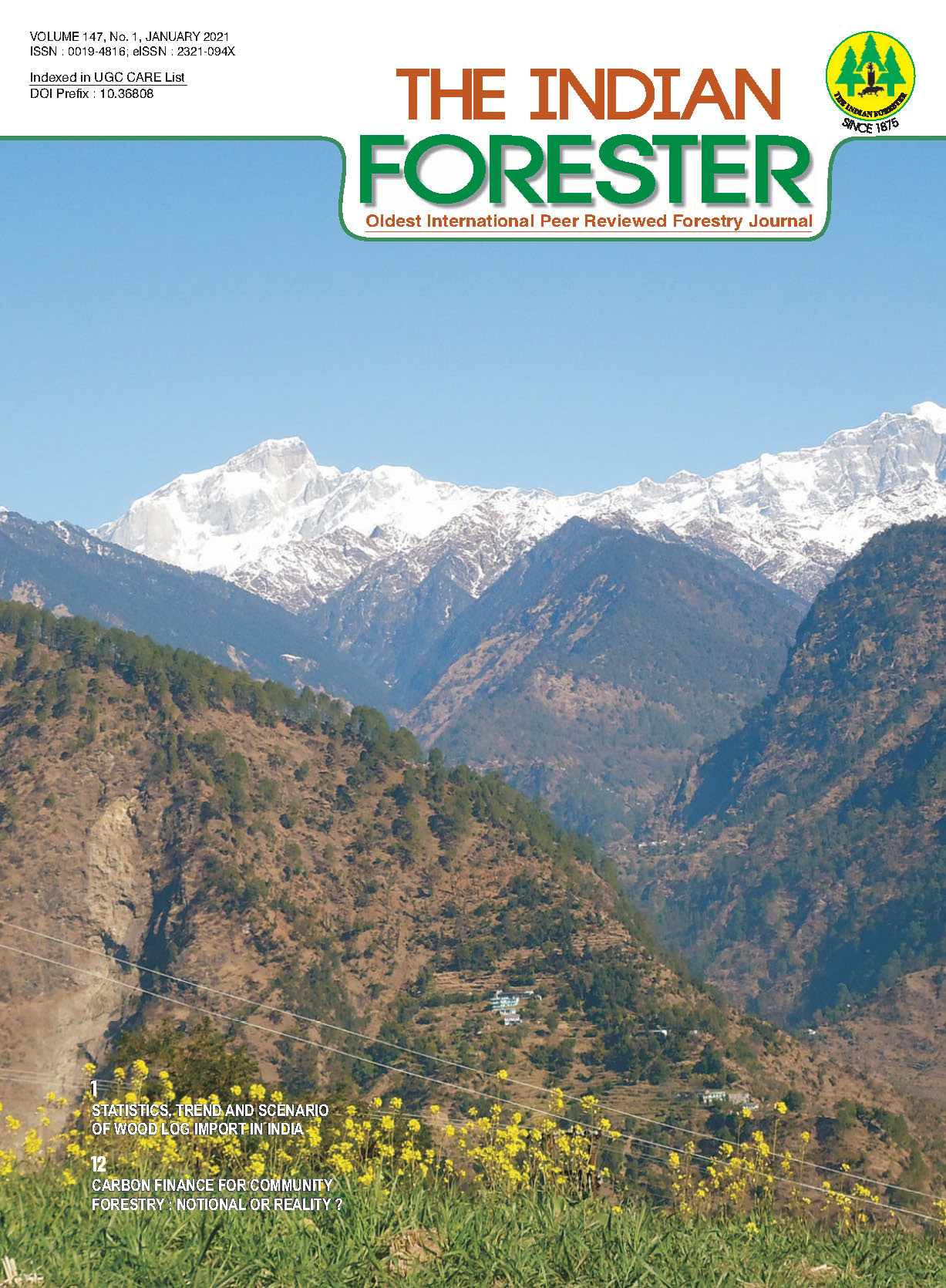Distribution, Growth and Yield of Santalum album L. in Karnataka, India
DOI:
https://doi.org/10.36808/if/2021/v147i1/152808Keywords:
Santalum album L., Distribution, Growth, Yield, Sandalwood, Karnataka.Abstract
Santalum album L. is distributed from Indonesia in the West to Juan Fernandez Islands in the East and from Hawaiian Archipelago in the North to New Zealand in the South. Sandalwood is one of the most important economic tree species harvested mainly for its heartwood and oil and is used in India from the earliest historic times.
The sandalwood stands are under immense pressure and their management is becoming increasingly complex. Unfortunately, efforts aimed at conserving the genetic resources of sandalwood suffer from want of precise information on the area coverage, present status, growth characteristics and diameter size class distribution. In Karnataka, S. album is mainly found in Shimoga, Chickamagalur, Coorg, Hassan, Mysore, Dharwad, Bangalore, Kolar, Belguam, Uttar Kannada, Dakshin Kannada, Bellary and Tumkur districts.
Keeping this in view, 41 sample plots were layed-out in sandal wood estates under Karnataka Forest Department. Out of 41 plots, 19 plots were laid out in sandalwood plantations (plantation plots), 4 plots were laid in regeneration plot and 18 plots are natural plots. The younger age plantations (3 - 6 years) are seen in Kadur, Bidar, Bangarpete, Srinivaspur, Malur, Mysore, Dharwad, Yelawala, and Kaggalipura ranges. Older plantation (15 - 20 years) are seen in Ambligola, Shkaripura, Shiralkoppa, Bangalore, Dundsi, Dharwad and JB kaval range. Significant variation in height and diameter growth was observed in all the sampled plots. Growth in Bangalore forest range was superior with 10.39 m of height and 11.52 cm of dbh compared to other ranges having natural distribution. Among the older trees grown under natural conditions, trees in Kadur range showed better height of 7.8 m and diameter of 8.31 cm.
References
Ananthapadmanabha H.S. (2000). Sandalwood and its marketing trend. Myforest, 36: 147-151.
Anon.. (2005). Annual Report, Karnataka Forest Department.
Barrett D.R. (1988). Santalum album (Indian Sandalwood) literature survey. Mulga Research Center, Western Australia.
Doran J.C., L. Thomson, J.J. Brophy, B. Goldsack, P. Bulai, T. Faka'osi and T. Mokoia. (2005). Variation in heartwood oil composition of young sandalwood trees in the south Pacific (Santalum yasi, S. album and F1 hybrids in Fiji, and S. yasi in Tonga and Niue). Sandalwood Research Newsletter, 20: 3-7.
Jain S.H., C.R. Rangaswamy and C.R. Sharma. (1988). Soil properties and their relationship to the growth of sandal (Santalum album L.) in three study area in Karnataka. Myforest 24: 141-146.
Jain S.H., V.G. Angadi and K.H. Shankaranarayana. (2003). Edaphic, environmental and genetic factors associated with growth and adaptability of sandal (Santalum album L.) in provenances. Sandalwood Research Newsletter, 17: 6-7.
Kumaravelu G., Bharathi R.K., Jainludeen A. and Balraj V.C. (2007). Resurrection of the rare aromatic Santalum album population in Tamil Nadu. Pp. 14-22. In: Gairola, S., Rathore, T.S., Joshi, G., Arun Kumar, A.N. and Aggarwal, P.K. (eds.) Conservation, Improvement, Cultivation and Management of Sandal (Santalum album L.). IWST, Bangalore.
Nageswara Rao, M, K.N. Ganeshaiah and R. Uma Shaanker. (2001). Mapping genetic diversity of sandal (Santalum album L.) in south India: lessons for in-situ conservation of sandal genetic resources. In: Forest genetic resources: status, threats and conservation strategies (Uma Shaanker, R, Ganeshaiah, KN, Bawa, KS eds). Oxford and IBH Publ, New Delhi, India, pp 49-67.
Neil P.E. (1986). Sandalwood in Vanuatu. Forest Research Report 5/86, Vanuatu Forest Service, Vanuatu.
Rai S.N. and C.R. Sharma (1990). Depleting sandalwood production and raising prices. Indian Forester, (5): 348-355.
Rai S.N. (1990). Status and cultivation of Sandalwood in India. USDA Forest Service Gen. Tech. Rep. PSW - 122.
Rangaswamy C.R., H.S. Ananthapadmanabha, S.H. Jain and H.C. Nagaveni. (1986). Nutrient uptake and host- requirement of sandal. Van vigyan, 24: 75-79.
Shetty R.H. (1977). Sandal-an exotic? Indian Forester, 103(5): 359-367.
Singh B.K. and P. Shankar (2007). Status of sandalwood (Santalum album L.) in Karnataka Paper presented at the National seminar on Conservation, Improvement, Cultivation and Management of Sandal (Santalum album L.) held at Institute of Wood Science and Technology during 12-13. December 2007.
Srinivasan V.V., V.R. Sivaramakrishnan, C.R. Rangaswamy, H.S. Ananthapadmanabha and K.H. Shankaranarayana (1992). Sandal. ICFRE, Dehradun, 233p.
Tewari V.P., D.N. Sheetalkumari, H.V. Sangamesh and N. Chandrashekar (2014). Distribution, Growth & yield and Demand & Supply of Santalum album: Survey & Review In: Conference: International Seminar on 'Sandalwood: Current Trends and Future Prospects, held at Institute of Wood Science and Technology, Bangalore on 26 - 28, 2014.
Venkatesan K.R. (1980). A fresh look at the management of sandal. Proc. Of Second Forestry Conference, FRI & Colleges, Dehradun.
Downloads
Downloads
Published
How to Cite
Issue
Section
License
Unless otherwise stated, copyright or similar rights in all materials presented on the site, including graphical images, are owned by Indian Forester.





